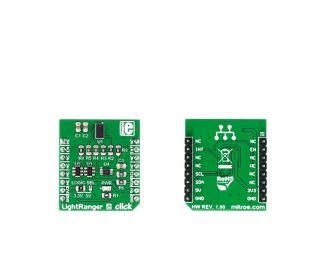
We strongly encourage users to use Package manager for sharing their code on Libstock website, because it boosts your efficiency and leaves the end user with no room for error. [more info]

Rating:
Author: MIKROE
Last Updated: 2019-07-31
Package Version: 1.0.0.1
mikroSDK Library: 1.0.0.0
Category: Optical
Downloaded: 5520 times
Not followed.
License: MIT license
LightRanger 2 click carries VL53L0X IC from STMicroelectronics, the word’s smallest Time-of-Flight ranging and gesture detector sensor. The click is designed to run on either 3.3V or 5V power supply. LightRanger 2 click communicates with the target microcontroller over I2C interface and the following pins on the mikroBUS line: RST, INT.
Do you want to subscribe in order to receive notifications regarding "LightRanger 2 click" changes.
Do you want to unsubscribe in order to stop receiving notifications regarding "LightRanger 2 click" changes.
Do you want to report abuse regarding "LightRanger 2 click".

Library Description
The library covers all the necessary functions to control LightRanger 2 Click board. A library performs the communication with the device via I2C driver.
Key functions:
void lightranger2_writeByte( uint8_t regAddress, uint8_t writeData ) - Generic write 8-bit data function.LIGHTRANGER2_STATUS_T lightranger2_defaultConfig() - Set default configuration function.uint16_t lightranger2_getRangeContinuous() - Get a range measurement ( continuous mode ) function.The application is composed of the three sections :
void applicationTask()
{
lightranger2_startContinuous( 0 );
Delay_10ms();
distance = lightranger2_getRangeContinuous();
Delay_10ms();
if ( distance )
{
mikrobus_logWrite( " Distance: ", _LOG_TEXT );
WordToStr( distance, logText );
ltrim( logText );
mikrobus_logWrite( logText, _LOG_TEXT );
mikrobus_logWrite( " mm", _LOG_LINE );
mikrobus_logWrite( "---------------------", _LOG_LINE );
Delay_1sec();
}
}
Other mikroE Libraries used in the example:
I2CUARTConversionAdditional notes and informations
Depending on the development board you are using, you may need USB UART click, USB UART 2 click or RS232 click to connect to your PC, for development systems with no UART to USB interface available on the board. The terminal available in all MikroElektronika compilers, or any other terminal application of your choice, can be used to read the message.